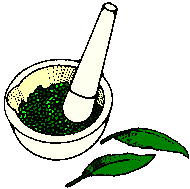Herbology

Since the dawn of creation, plants have been the primary source of medicine for the human race.
Medicinal plants have been mentioned in the Bible, and in historical literature. Plants that are used as medicines have been referred to as "herbs" for over 4000 years by European and the Mediterranean cultures, hence the word "herb", being a derivation of "herbe" and the Latin word, "herba".
Originally, the term "herb" only applied to non-woody plants.
Today, "herb" refers to any part of any plant used for flavoring or medicine. Although the term "herb" can also be equated with food spices, it is generally used in reference to any plant, or any part of a plant, having nutritional and / or medicinal value's. Additionally, an "herb" may be a fruit, a bark, a flower, a leaf, or a root, as well as anon-woody plant.
There are several types of herbal medicine systems that are used today; European, Native American, Chinese, Ayurvedic, and Western herbalism are the most prevalent systems. Despite differences in terminology and in the herbs used, there is a common thread that joins these systems: all of these systems treat the body as a 'whole', and they each utilize the energy of plants to 'work as needed' in synergy with the natural energy in each individual.
Because there are many different herbal systems, there are also many different ways of classifying herbs. Some systems being used over the years tend to classify herbs by 'plant part'; by humoral theories; by botanical family; by color; or by morphology. One example is the Chinese system, which has a complex classification system based on 'chi', or 'body energy concepts'. This classification scheme is very successful at correlating the human body to proper herb usage, but does not provide for easy substitution of one herb for another.
There are many other ways to classify herbs. Another simple method is to identify five (5) major herbal categories:
Aromatic (volatile oils) Astringent (tannins) Bitter (phenol compounds, saponins and alkaloids) Mucilaginous (polysaccharides) Nutritive (food stuffs)
This category system makes it easy to identify herbs using 'taste' and 'smell', and becomes useful when needing to substitute herbs for one another.
There are many ways to grow, gather, and harvest herbs. Herbs are considered the "best" by some practitioners when they are naturally grown in the wild, untouched by industrial pollutants. Others prefer herbs that are cultivated indoors, away from all contaminants, in a controlled environment. Some herbalist's recommend gathering only certain herbs (depending on the seasons, the weather, and the time of day) to achieve the highest level of medicinal qualities. And still others may disregard this practice, and will purposefully plant herbs 'out of season' so that they will be available for sale year round.
Many believe that the energy with which the herbs are gathered is also very important, and should always be done with great spiritual awareness and prayerful thankfulness. And others feel that herbs should be handled with reverence and respect.
In addition to growth and gathering techniques, harvesting practices vary as well. Recommendations may include taking the whole plant at once (buds, roots, seeds, leaves and blooms), or taking each part of the plant in a particular order, and only using younger, or older, plants.
There are also several ways to dispense herbs. The most common methods are herbal pastes, juices, decoctions, hot or cold infusions, powders, pills (tablets, capsules), aromatics, tinctures or extracts (alcohol or glycerol bases), liniments, syrups, poultices and fomentations, medicated oils, salves and ointments, lotions, teas, and whole herbs. Each type is good for specific ailments, and often may be used together (i.e. internally and externally for an external wound) to take full advantage of the healing attributes of each.
All these choices, like others, should be integrated with both your personal external needs and your internal ideals for the best possible results. An experienced herbalist can help you decide which system is right for you. Please be aware that herbs are foods. And like any other food, herbs should be taken in moderation. Always follow the manufacturer's directions for use.
In Chinese medicine herbs are associated with the major organs of the body. For example - certain herbs are used to heal lung ailments and the meridians associated with the lungs. The practitioner will always provide the patient with 2 herbs. One is called the guiding herb that gets the healing herb to the right spot. The second herb is the healing herb. Much of this is intuitive - as the body will crave the food, tastes, or herbs that it needs.
In plant spirit medicine the practitioner not only administers the healing herb but he has a relationship with the Spirit of the healing plant. He can actually communicate with the spirit of a powerful healing plant to heal the patient. This can be done as a remote healing - with patient and practitioner in two different parts of the country. In this case the spirit goes to the patient. According to author and shaman, Eliot Cowan - Plant Spirit Medicine -
"Some people find it difficult to accept the concept of plants communicating with earthlings. Such plant communication can be in the form of a plant speaking directly to an individual, or quite often, an individual seeing a plant spirit. For many, such an occurrence would be outside their boundary of reality. He takes the leaves of a plant to make a tea, and then with different forms of meditation, communicates with the plant to produce a healing for the patient. This is accomplished regardless of whether the disease is physical, mental or both. In my opinion, this in itself would certainly be worth writing about.
"After introductions, the healer asks the plant spirit to teach the Shaman how to use this plant. The teaching comes in many forms that may even including a non-verbal transfer of the information. When the transfer is complete, the shaman then returns to a normal state of consciousness and immediately starts to record the entire experience. Next there follows an interpretation of the dream and as is generally true for dreams, the dream may or may not be self explanatory. As the author states, "If I can make that relationship with the spirit of the plant, I don't need the leaf or the root with which to heal.... instead, I ask the messenger (the plant) to bring the spirit of whatever plant that person needs. So instead of having or harvesting dozens of plants that I have to take with me, I just have pills or capsules made out of the messenger plant."
This ability to communicate with a messenger plant is revolutionary. Presently the practice of wild crafting is drawing more and more criticism because it encourages the over harvesting of medicinal plants. I am personally aware of "over harvesting" as I witness the identical situation occurring with the medicinal plants of ginseng, and especially goldenseal. Under present circumstances, goldenseal is even now at the point of being an endangered species.
This wonderful ability to communicate with a messenger plant, which in turn eliminates the need of harvesting unnecessary plants, puts Eliot Cowan in a special place in the realm of plant spirit healing. This is an arena which even Cowan admits, "we don't control the spirit or even understand it. Humility is the way."
East meets West: A new memory enhancing drug based on Chinese herbal medicine
August 22, 2000 -
Blacksburg, Va., August 22, 2000 -- Huperzine A, a compound isolated from the Chinese Medicinal Herb "Qian Ceng Ta," has shown good efficacy in improving the memory in patients suffering from Alzheimer's Disease. Despite these promising results, Huperzine A has not been developed as a drug in the West due to scarcity of the natural source, a complicated molecular structure, and the lack of intellectual property protection for this material. Virginia Tech researcher Paul R. Carlier, an associate professor of chemistry, has come up with a novel solution to these problems.
Carlier will present his research at the 220th national meeting of the American Chemical Society Aug. 20-24 in Washington, D.C.
Working in collaboration with researchers at the Hong Kong University of Science and Technology (HKUST) and the Mayo Clinic, Carlier found that a highly simplified fragment of the Huperzine A molecule could be easily synthesized from cheap, commercially available chemicals. In isolation this fragment is ineffective as a memory enhancer. However, based on a detailed analysis of acetylcholinesterase, the brain enzyme with which Huperzine A interacts, Carlier prepared dimeric analogs by joining two of these fragments with a molecular tether.
Working in collaboration with researchers at the Hong Kong University of Science and Technology (HKUST) and the Mayo Clinic, Carlier found that a highly simplified fragment of the Huperzine A molecule could be easily synthesized from cheap, commercially available chemicals. In isolation this fragment is ineffective as a memory enhancer. However, based on a detailed analysis of acetylcholinesterase, the brain enzyme with which Huperzine A interacts, Carlier prepared dimeric analogs by joining two of these fragments with a molecular tether.
Remarkably, the optimum drug obtained by this approach, ('Huperzine A Fragment Dimer') is more than twice as potent as Huperzine A itself," he reports. "The enhanced potency observed is due to two-point attachment of the dimeric drug to acetylcholinesterase," he says.
Carlier stresses that all of the tests have been in animals, including a behavioral assay in rats that establishes improved memory.
"No work has been done in humans; and, even if the compounds prove effective in human, it will be as a treatment of the memory loss in the early stages of the disease," he says. "This approach could never cure Alzheimer's; and, after the disease progresses to a certain point, these drugs could not restore mental function."
Tribal cures for modern ailments

The deal is a leap into the unknown for the tribe
An Amerindian tribe in Surinam has reached a deal with the outside world to allow the collecting of plant samples in their forest for medicinal research.
The agreement comes as pharmaceutical companies are returning to the Earth's forests in their search for new medicines to cure some of mankind's biggest killers, such as Aids, cancer and malaria. This is called bio-prospecting.
But randomly collecting plants is not the most effective way to do this.
According to Conservation International, (CI), an American environmental organization, if plant collectors work alongside the tribe's shaman, or medicine man, they are 50% more likely to find an active compound. They say that over 74% of today's plant-derived medicines were previously used for similar purposes by indigenous people.
On the organization's first bio-prospecting trip with the Trio shaman Amasina, they found two plant species new to western science, and 14 other plants with previously unknown medicinal properties.
Conservation International have now drawn up a contract with the Trio, in the village of Kwamalasamutu, to go plant collecting for five years.
Both parties, as well as the American pharmaceutical giant Bristol Myers Squibb, are part of the International Co-operative Biodiversity Group (ICBG).
Conservation International have initiated the bio-prospecting program as a way of providing economic alternatives to logging and mining in rainforests, and to help protect biodiversity and indigenous peoples' knowledge of traditional medicine.
Stan Malone, director of CI-Surinam, led a delegation of ICBG representatives to Kwamalasamutu to present the bio-prospecting contract to the granman, or chief, of the village.
He explained every aspect of the agreement through an interpreter, using pictures and diagrams to show the process of drug development from shaman to pharmaceutical company.
He is concerned that these tribes might not fully comprehend the implications of these agreements because their outlook on life is so different, and that there is no clear international legal framework to protect their rights in the long-term. He also doubts whether indigenous communities necessarily have the right to surrender plants that might grow in other countries too.

Traditional application of herbal cure
The Trio tribe were converted to Christianity by American missionaries in the 60s, but their lifestyle is still traditional. They hunt, fish, and tend small plantations.
Their staple food is cassava, from which they make cassava bread and brew kasiri, cassava beer.
They have access to western medicine at the government-run clinic, but if that fails then they turn to the shaman.

Improved collection with local shaman
There are very few shaman left in the village. In order to keep the knowledge alive two have started teaching basic plant knowledge in the village school.
According to Amasina "the children want to learn about plant medicine because they want to be able to cure people, but of course the money makes sense to them too, they want to profit from the knowledge".
This village barely has enough electricity and running water at the moment, and they rely on the Surinam Government for goods such as fuel.They say they want development, by which they usually mean western luxury goods such as refrigerators and televisions. The children love Nike sports clothes and trainers.
The bio-prospecting agreement they have signed could potentially provide these things. However they are coming to realize that they must preserve the ancient knowledge they cultivated in the past in order to change their lives in the future.
Find me on Social Media
 |
Don't forget to bookmark my site to see updates..
Copyright © 2000 - 2025 K.
Kerr
|






